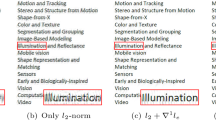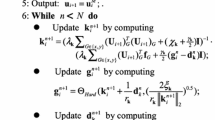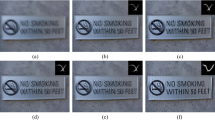Abstract
Blind deblurring has undergone rapid development since the variational Bayes method of Fergus et al. about 15 years ago. Nowadays, it is generally acknowledged in the statistical view that unnatural heavy-tailed image priors should be advocated for blind deblurring. However, this paper affirms that an image prior driven by the dual principles of discriminativeness is indeed more critical and essential to blind deblurring, inspired by which a new type of reweighted Tikohonov image regularization is formulated. In comparison with previous approaches, the model in this paper is not only more concise in mathematics but also more intuitive in understanding. Experimenting within a plug-and-play numerical framework on images of natural, manmade, low-illumination, text, and people classes well validate the effectiveness and robustness of the proposed model. More importantly, its practicality to realistic challenging deblurring problems is also demonstrated. In the final, it is believed that this paper could break a long-standing prejudice on maximum-a-posterior-based blind deblurring, i.e., various modeling tricks should be developed to ensure top performance of blind deblurring. However, this paper states that the problem can be formulated in a more strict modeling fashion, just similar to the non-blind deblurring task in a great sense.















Similar content being viewed by others
References
Almeida, M., & Almeida, L. (2010). Blind and semi-blind deblurring of natural images. IEEE TIP, 19(1), 36–52.
Babacan, S. D., Molina, R., Do, M. N., Katsaggelos, A. K. (2012). “Bayesian Blind Deconvolution with General Sparse Image Priors,” A. Fitzgibbon et al. (Eds.): ECCV 2012, Part VI, Lecture notes in computer science, vol. 7577, pp. 341–355.
Babacan, S. D., Molina, R., & Katsaggelos, A. K. (2009). Variational bayesian blind deconvolution using a total variation prior. IEEE TIP, 18(1), 12–26.
Bai, Y., Cheung, G., Liu, X., & Gao, W. (2019). Graph-based blind image deblurring from a single photograph. IEEE TIP, 28(3), 1404–1418.
Brifman, A., Romano, Y., & Elad, M. (2016). Turning a denoiser into a super-resolver using plug-and-play priors,” ICIP.
Cai, J. F., Ji, H., Liu, C., & Shen, Z. (2012). Framelet-based blind motion deblurring from a single image. IEEE Transactions on Image Processing, 21(2), 562–572.
Cai, J., Zuo, W., & Zhang, L. (2020). Dark and bright channel prior embedded network for dynamic scene deblurring. IEEE Transactions on Image Processing, 29, 6885–6897.
Chakrabart, A. (2016). “A neural approach to blind motion deblurring,” ECCV, pp. 221–235.
Chan, S. H., Wang, X., & Elgendy, O. A. (2017). Plug-and-play ADMM for image restoration: Fixed-point convergence and applications. IEEE TCI, 3(1), 84–98.
Chan, T. F., & Wong, C. K. (1998). Total variation blind deconvolution. IEEE TIP, 7(3), 370–375.
Cho, S., & Lee, S. (2009). Fast motion deblurring. ACM Transaction on Graphics, 28(5), 1–8.
Dabov, K., Foi, A., Katkovnik, V., & Egiazarian, K. (2007). Image denoising by sparse 3-d transform-domain collaborative filtering. IEEE TIP, 16(8), 2080–2095.
Egiazarian, K., Katkovnik, V. (2015). “Single image superresolution via BM3D sparse coding,” ESPC, pp. 2849–2853.
Fergus, R., Singh, B., Hertzmann, A., Roweis, S. T., & Freeman, W. T. (2006). Removing camera shake from a single photograph. ACM Transactions on Graphics, 25(3), 787–794.
Goodfellow, I., Pouget-Abadie, J., Mirza, M. (2014). Generative adversarial networks, NIPS, pp. 2672–2680.
Harmeling, S., Michael, H., & Schölkopf, B. (2010). “Space variant single-image blind deconvolution for removing camera shake,” NIPS, pp. 829–837.
Hirsch, M., Schuler, C. J., Harmeling, S., Schölkopf, B. (2011). “Fast removal of non-uniform camera-shake,” ICCV.
Hu, Z., Cho, S., Wang, J., & Yang, M.-H. (2014). “Deblurring lowlight images with light streaks,” CVPR, pp. 3382–3389.
Köhler, R., Hirsch, M., Mohler, B., Schölkopf, B., Harmeling, S. (2012). “Recording and playback of camera shake: Benchmarking blind deconvolution with a real-world database,” ICCV
Kotera, J., Sroubek, F., Milanfar, P. (2013). “Blind deconvolution using alternating maximum a posteriori estimation with heavy- tailed priors,” R. Wilson et al. (Eds.): CAIP, Part II, Lecture Notes in Computer Science, vol. 8048, pp. 59–66.
Kotera, J., Šmídl, V., & Šroubek, F. (2017). Blind deconvolution with model discrepancies. IEEE TIP, 26(5), 2533–2544.
Krishnan, D., Tay, T., Fergus, R. (2011) “Blind deconvolution using a normalized sparsity measure,” CVPR, pp.233–240.
Krishnan, D., & Fergus, R. (2009). Fast image deconvolution using hyper-laplacian priors. NIPS, 22, 1033–1041.
Kupyn, O., Budzan, V., Mykhailych, M., Mishkin, D., Matas, J. (2018). “Deblurgan: Blind motion deblurring using conditional adversarial networks,” CVPR, pp. 8183–8192.
Kupyn, O., Martyniuk, T., Wu, J., Wang, Z. (2019). “DeblurGAN-v2: Deblurring (Orders-of-Magnitude) faster and better,” ICCV.
Lai, W.S., Ding, J.-J., Lin, Y.-Y., and Chuang, Y.-Y. (2015). “Blur Kernel Estimation Using Normalized Color-Line Prior,” CVPR.
Lai, W. S., Huang, J. B., Hu, Z., Ahuja, N., Yang, M. H., (2016). “A comparative study for single image blind deblurring,” CVPR, pp. 1701–1709.
LeCun, Y., Yoshua, B., & Hinton, G. (2015). Deep learning. Nature, 521(7553), 436–444.
Levin, A., Weiss, Y., Durand, F., Freeman, W. T. (2011a). “Efficient Marginal Likelihood Optimization in Blind Deconvolution,” CVPR, pp. 2657–2664.
Levin, A., Weiss, Y., Durand, F., & Freeman, W. T. (2011b). Understanding blind deconvolution algorithms. IEEE Trans. PAMI, 33(12), 2354–2367.
Li, L., Pan, J., Lai, W.-S., et al. (2018). Learning a discriminative prior for blind image deblurring, CVPR.
Li, Y., Tofighi, M., Geng, J., Monga, V., & Eldar, Y. C. (2020). Efficient and interpretable deep blind image deblurring via algorithm unrolling. IEEE Transactions on Computational Imaging, 6, 666–681.
Liu, J., Yan, M., & Zeng, T. (2021). Surface-aware blind image deblurring. IEEE Transactions on Pattern Analysis and Machine Intelligence, 43(3), 1041–1055.
Michaeli, T., & Irani, M. (2014). Blind deblurring using internal patch recurrence. ECCV, pp. 783–798.
Molina, R., Mateos, J., & Katsaggelos, A. K. (2006). Blind deconvolution using a variational approach to parameter, image, and blur estimation. IEEE TIP, 15(12), 3715–3727.
Money, J. H., & Kang, S. H. (2008). Total variation minimizing blind deconvolution with shock filter reference. Image and Vision Computing, 26(2), 302–314.
Nah, S., Kim, T. H., Lee, K. M. (2017). “Deep multi-scale convolutional neural network for dynamic scene deblurring,” CVPR.
Nimisha, T. M., Singh, A. K., Rajagopalan, A. N. (2017). “Blur-invariant deep learning for blind-deblurring,” ICCV.
Pan, J., Hu, Z., Su, Z., Yang, M.-H. (2014a). “Deblurring text images via L0-regularized intensity and gradient prior,” CVPR.
Pan, J., Hu, Z., Su, Z., & Yang, M.-H. (2014b). “Deblurring face images with exemplars,” ECCV, pp. 47–62.
Pan, J., Sun, D., Pfister, H., Yang, M. H. (2018). “Deblurring Images via Dark Channel Prior,” IEEE Transactions on Pattern Analysis and Machine Intelligence, pp. 2315–2328.
Pan, J., Lin, Z., Su, Z., Yang, M.-H. (2016). “Robust kernel estimation with outliers handling for image deblurring,” CVPR.
Pan, J., & Su, Z. (2013). Fast L0-regularized kernel estimation for robust motion deblurring. IEEE Signal Processing Letters, 20(9), 1107–1114.
Perrone, D., & Favaro, P. (2016). A clearer picture of total variation blind deconvolution. IEEE Transactions on Pattern Analysis and Machine Intelligence, 38(6), 1041–1055.
Perrone, D., & Favaro, P. (2016b). A logarithmic image prior for blind deconvolution. IJCV, 117(2), 159–172.
Ren, W., Cao, X., Pan, J., Guo, X., Zuo, W., & Yang, M.-H. (2016). Image deblurring via enhanced low-rank prior. IEEE Transactions Image Processing, 25(7), 3426–3437.
Romano, Y., Elad, M., & Milanfar, P. (2017). The little engine that cloud: regularization by denoising (RED). SIAM Journal on Imaging Science, 10, 1804–1844.
Rond, A., Giryes, R., & Elad, M. (2016). Poisson inverse problemsby the plug-and-play scheme. Journal of Visual Communication and Image Representation, 41, 96–108.
Roth, S., & Black, M. J. (2009). Fields of Experts. International Journal of Computer Vision, 82(2), 205–229.
Schuler, C., Hirsch, M., Harmeling, S., & Scholkopf, B. (2016). Learning to Deblur. IEEE Transactions on pattern analysis and machine intelligence, 38(7), 1439–1451.
Shan, Q., Jia, J., & Agarwala, A. (2008). High-quality motion deblurring from a single image (pp. 1–10). SIGGRAPH.
Shao, W. Z., Lin, Y. Z., Bao, B. K., Wang, L. Q., Ge, Q., Li., H., (2018). Blind deblurring using discriminative image smoothing, Chinese Conf. Pattern Recognition & Computer Vision, pp. 490-500.
Shao, W., Deng, H., Ge, Q., Li, H., & Wei, Z. (2016). Regularized motion blur-kernel estimation with adaptive sparse image prior learning. Pattern Recognition, 51, 402–424.
Shao, W. Z., Ge, Q., Deng, H. S., Wei, Z. H., & Li, H. B. (2015b). “Motion deblurring using non-stationary image modeling. Journal of Mathematical Imaging and Vision, 52(2), 234–248.
Shao, W., Li, H., & Elad, M. (2015a). Bi-L0-L2-norm regularization for blind motion deblurring. Journal Visual Communication and Image Representation, 33, 42–59.
Shearer, P., Gilbert, A. C., Hero III, A. O. (2013). “Correcting camera shake by incremental sparse approximation,” ICIP.
Sreehari, S., Venkatakrishnan, S., Wohlberg, B., Drummy, L. F., Simmons, J. P., & Bouman, C. A. (2015). “Plug-and-play priors for bright field electron tomography and sparse interpolation,” arXiv preprint arXiv:1512.07331.
Sun, L., Cho, S., Wang, J., & Hays, J. (2013). “Edge-based blur kernel estimation using patch priors,” ICCP.
Sun, J., Cao, W., Xu, Z., Ponce, J. (2015). “Learning a convolutional neural network for non-uniform motion blur removal,” CVPR, pp. 769–777.
Tao, X., Gao, H., & Wang, Y. (2018). “Scale-recurrent network for deep image deblurring,” CVPR, pp. 8174–8182.
Venkatakrishnan, S. V., Bouman, C. A., Wohlberg, B. (2013). “Plug-and-play Priors for Model based Reconstruction,” IEEE Global conference on signal and information processing, pp. 945–948
Wang, R., & Tao, D. (2014). Recent progress in image deblurring, arXiv:1409.6838
Wang, Z., Bovik, A. C., Sheikh, H. R., & Simoncelli, E. P. (2004). Image quality assessment: From error visibility to structural similarity. IEEE TIP, 13(4), 600–612.
Wen, F., Ying, R., Liu, P., et al. (2019). “Blind image deblurring using patch-wise minimal pixels regularization,” arXiv:1906.06642.
Whyte, O., Sivic, J., Zisserman, A. (2011). “Deblurring Shaken and Partially Saturated Images,” IEEE Color and Photometry in Computer Vision Workshop, in conjunction with ICCV.
Whyte, O., Sivic, J., Zisserman, A. (2014). “Deblurring shaken and partially saturated images,” IJCV, 110(2), pp. 185–201.
Whyte, O., Sivic, J., Zisserman, A., & Ponce, J. (2012). Non-uniform deblurring for shaken images. IJCV, 98(2), 168–186.
Wieschollek, P., Schölkopf, B., Lensch, H. P. A., et al., (2016). “End-to-end learning for image burst deblurring,” ACCV.
Wipf, D., & Zhang, H. (2014). Revisiting bayesian blind deconvolution. J. Machine Learning Research, 15, 3595–3634.
Wu, J., & Di, X. (2020). Integrating neural networks into the blind deblurring framework to compete with the end-to-end learning-based methods. IEEE Transactions on Image Processing, 29, 6841–6851.
Xu, L., Zheng, S., Jia, J. (2013). “Unnatural L0 sparse representation for natural image deblurring,” CVPR, pp. 1107–1114.
Xu, L., & Jia, J. (2010). Two-phase Kernel Estimation for Robust Motion Deblurring. ECCV, Part i, LNCS, 6311, 157–170.
Xu, L., Yan, Q., Xia, Y., & Jia, J. (2012). Structure extraction from texture via relative total variation. ACM Transactions on Graphics, 31(6), 10.
Yan, Y., Ren, W., Guo, Y., Wang, R., & Cao, X. (2017). “Image deblurring via extreme channels prior,” CVPR.
You, Y.-L., & Kaveh, M. (1996). A regularization approach to joint blur identification and image restoration. IEEE Transaction on Image Processing, 5(3), 416–28.
Zhang, H., Wipf, D., Zhang, Y. (2013). Multi-image blind deblurring using a coupled adaptive sparse prior, CVPR
Zhang, J., Pan, J., Ren, J., Song, Y., Bao, L., Lau, R., Yang, M.-H. (2018). “Dynamic scene deblurring using spatially variant recurrent neural networks,” CVPR.
Zhong, L., Cho, S., Metaxas, D., Paris, S., & Wang, J. (2013). “Handling noise in single image deblurring using directional filters,” CVPR, pp. 612–619.
Zoran, D., & Weiss, Y. (2011). “From learning models of natural image patches to whole image restoration,” ICCV.
Zuo, W., Ren, D., Gu, S., Lin, L., & Zhang, L. (2016). Learning iteration-wise generalized shrinkage-thresholding operators for blind deconvolution. IEEE TIP, 25(4), 1751–1764.
Acknowledgements
The work was supported in part by the Natural Science Foundation of China (61771250, 61972213, 11901299) and in part by the Fundamental Research Funds for the Central Universities (30918014108).
Author information
Authors and Affiliations
Corresponding author
Additional information
Publisher's Note
Springer Nature remains neutral with regard to jurisdictional claims in published maps and institutional affiliations.
Rights and permissions
Springer Nature or its licensor (e.g. a society or other partner) holds exclusive rights to this article under a publishing agreement with the author(s) or other rightsholder(s); author self-archiving of the accepted manuscript version of this article is solely governed by the terms of such publishing agreement and applicable law.
About this article
Cite this article
Shao, WZ., Deng, HS., Ge, Q. et al. RTR-DPD: reweighted tikohonov regularization for blind deblurring via dual principles of discriminativeness. Multidim Syst Sign Process 34, 291–320 (2023). https://doi.org/10.1007/s11045-022-00863-7
Received:
Revised:
Accepted:
Published:
Issue Date:
DOI: https://doi.org/10.1007/s11045-022-00863-7




